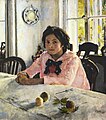Valentin Alexandrovich Serov
Valentin Serov ( Russian Валентин Александрович Серов ., Scientific transliteration Valentin Aleksandrovich Serov ; emphasis: Valentin Serov , born January 7 . Jul / 19th January 1865 greg. In Saint Petersburg , † November 22 jul. / 5. December 1911 greg. in Moscow ) was a Russian painter , graphic artist and portrait painter . He is considered a representative of Russian Art Nouveau painting .
Life
He grew up in the family of the composer Alexander Nikolayevich Serov . After briefly attending grammar school, Ilya Repin taught him painting and drawing from 1878 to 1879 in Paris and Moscow . In the period from 1880 to 1885 he attended the Petersburg Art Academy under Pavel Chistjakov . Repin and Tschistjakow had a lasting influence on his early works. However, he was most influenced by the works of the Old Masters, which he got to know in museums in Russia and Western Europe.
Serov left the academy with a silver medal and began working as a freelance painter. One of his best-known and first significant works was The Girl with the Peaches (Девочка с персиками) from 1887, which Vera, the daughter of the industrialist and art patron Savva Mamontov , is showing and is now on display in the Tretyakov Gallery in Moscow . This picture is one of the works of early Russian Impressionism .
From 1890 he turned his main focus on painting portraits . In the following years he mainly portrayed people from contemporary history, such as actors , artists and writers . These include, for example, Isaak Levitan (1893), Nikolai Leskow (1894) and Nikolai Rimski-Korsakow , whom he portrayed in 1898. These portraits are also exhibited in the Tretyakov Gallery today.
In 1894 Serov joined the Peredwischniki movement . Around this time he increasingly began to paint family portraits, mainly of children and women. In his portraits of children, he attached great importance to poses and gestures in order to capture the spontaneity of the moment in the movements. Examples of this are the portraits of children (Дети) from 1899 and Mika Morosow (Мика Морозов), created in 1901. They can be found in the Tretyakov Gallery.
In his later creative phase, Serow varied different painting techniques - water colors, pastel colors, lithographs , etc. His portraits were gradually refined. These were above all the portraits of Vasily Katschalow , Tamara Karsavina , numerous characters from the stories of Ivan Krylov . These works were created between 1908 and 1911 and can be seen in the Tretyakov Gallery, the Russian Museum and other galleries.
In the period from 1890 to the beginning of the 20th century, Serow created many landscape paintings . From 1897 to 1909 he also taught at the Moscow School of Painting, Sculpture and Architecture . Among his students were Pavel Kuznetsov , Nikolai Sapunov , Martiros Sarjan , Kuzma Petrow-Vodkin , Nikolai Ulyanov and Konstantin Juon .
After the turn of the century, Serow returned to portraiture. In 1904, for example, he created a portrait of Maxim Gorky , which is now exhibited in the Gorky Museum in Moscow. Further portraits of the actress by Marija Jermolowa and a charcoal drawing of the opera singer Fyodor Chaliapin were created.
In the last years of his life he devoted himself to depicting themes from classical mythology and history.
Works
Nikolai Leskov (1894)
Felix Sumarokow-Elston (1903)
Ida Rubinstein (1910)
The Rape of Europa (1910)
Web links
- Works by Valentin Alexandrowitsch Serow at Zeno.org .
- Information about the artist and his works (Russian)
- Valentin Alexandrowitsch Serow in Google Arts & Culture
| personal data | |
|---|---|
| SURNAME | Serov, Valentin Alexandrovich |
| ALTERNATIVE NAMES | Серов, Валентин Александрович (Russian) |
| BRIEF DESCRIPTION | Russian painter and printmaker |
| DATE OF BIRTH | January 19, 1865 |
| PLACE OF BIRTH | St. Petersburg |
| DATE OF DEATH | December 5, 1911 |
| Place of death | Moscow |









